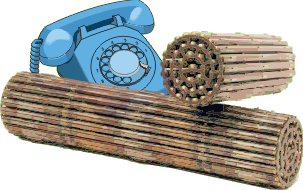|
Published in the June 2007
issue of the Canadian
Nuclear Society Bulletin, Vol.28, No.2.
The Telephone and the Fuel Bundle
by Jeremy Whitlock
One of the quirks of a small nuclear industry is that most of us know most things about it, most of the time. We have one reactor type, one reactor designer, one national lab, a handful of nuclear engineering schools, one Nobel Prize (two if you count Rutherford), one large research reactor, one staggeringly fertile uranium mine supplying the world, and a few thousand gainfully-employed souls.
We know our CANDU reactor runs safer and more efficiently than any other design, and doesn't need a nuclear weapons infrastructure for fuelling. We practically invented nuclear medicine, cancer radiotherapy, superconducting cyclotrons, yadda yadda yadda.
However, now and then a shiny nugget pops up which we happily pocket. Here then, for further edification and mortification around the water cooler, are Five Things You (Maybe) Didn't Know About the Canadian Nuclear Industry:
The CANDU fuel bundle of choice today contains 37 fuel pins arranged in rings of 1, 6, 12, and 18. The geometric arrangement of these pins is surprisingly similar to that of the 36 holes in those standard round telephone mouthpieces, in the days prior to the advent of lightweight, plastic handsets. The holes were arranged in rings of 6, 12, and 18, with similar angular offsets per ring. Presumably, the similarity is tied to a common requirement for equidistant two-dimensional spacing: in the fuel bundle's case for reasons of neutronics and thermalhydraulics, while the telephone mouthpiece is concerned more with structural strength and aesthetics.
In the 1960s AECL's major science project was ING, the "Intense Neutron Generator". This last brainchild of Wilfrid Bennett ("W.B.") Lewis' stellar career was an innovative 1.5 km linear accelerator intended to slam protons into a lead-bismuth target and spew out unheard-of gobs of neutrons. The design was as visionary as Lewis himself: its thermal neutron flux would exceed the maximum available on earth even today. However, a ballooning price tag and chronic squabbling over siting and mission, led the Trudeau government to pull the plug in 1968. Among ING's legacies was a world-leading accelerator physics capability within AECL that subsequently hatched the world's first superconducting cyclotron design.
Advanced fuel cycles may be fashionable today as the world struggles with strategic questions of sustainable supply, non-proliferation, and waste management, but the notion has been fundamental to CANDU design since the outset. Under a thorium fuel cycle the CANDU system can become self-sufficient in fuel-supply. In short, CANDU can burn everything but the kitchen sink (and perhaps even that as well, if it's coated with a thorium glaze).

If you thought the 1960s were heady days for Canada's nuclear community, the 1950s were positively stratospheric. Beginning with the invention of cobalt-60 cancer therapy, Canada spent the rest of the decade soaring ahead of the world in nuclear and solid-state physics (with Chalk River's NRX as the main experimental platform), and ended with the debut of the brilliant NRU at Chalk River and the equally brilliant MNR at McMaster University. Dedicated in 1959 by Prime Minister Diefenbaker, the Mac reactor was the largest in the British Commonwealth and a testimony to the foresight, tenacity, and stature of Dr. Henry Thode at the university. Thode was a vet of the NRC's wartime Montreal Lab (actually the only one who didn't work in Montreal, due to the non-portable nature of his mass spectrometry equipment at Mac). The 5 MW MTR-type reactor is something of a phenom in nuclear circles, having risen from imminent closure in the early 90s to comfortable viability today, supported by commercial production of mostly in-house developed isotopes.
Chalk River has been visited by many foreign dignitaries in its day, but one of the earliest occurred without hoopla. In 1953 the infant crown corporation AECL was tested early as it dealt with the unprecedented NRX accident from the previous December. During the ensuing 14 months it not only cleaned and repaired the facility, but also upgraded it for more powerful operation (yes, in only 14 months). The accident vaulted Canada to the forefront of both reactor safety philosophy and accident mitigation, but not without help from friends. Admiral Rickover's nuclear navy had tested materials and fuel in NRX, and now the facility's refurbishment became another training opportunity. Among the U.S. secondments during 1953 was 28-year-old Lieutenant Jimmy Carter, commanding a detail of naval personnel. Those who don't believe in fate are given pause by Carter's later job, presiding over the Three Mile Island accident as the 39th President of the United States.
|